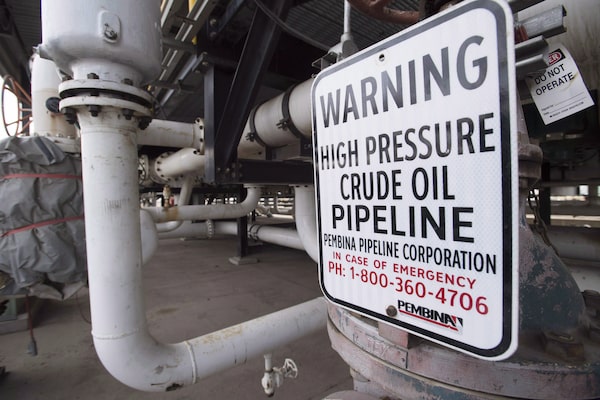
Pipes are seen at the Kinder Morgan Trans Mountain facility in Edmonton on April 6, 2017.Jonathan Hayward/The Canadian Press
Canadian oil companies operating in Western Canada are producing 202,000 more barrels of crude per day than there is total pipeline capacity, according to a new study from the National Energy Board.
The report, commissioned by the federal government, puts an official figure on the amount of oil oversupply coming from the Western Canadian Sedimentary Basin, which spreads from British Columbia to Saskatchewan. The amount of oversupply was measured in September, the most recent month for which data was available.
Because total pipeline capacity is not always available to producers owing to maintenance work, the NEB also studied production relative to normal pipeline movement. Using this metric, the oversupply amounts to 365,000 barrels a day (b/d).
Western Canada’s pipeline capacity has come into focus in recent months as the price of Canadian heavy crude, known as Western Canadian Select, saw its discount relative to benchmark North American oil plunge to US$50 a barrel in October, hurting oil producers as well as the Alberta government, which relies on royalties to help fund its spending.
The drop follows large investments by Canadian oil producers to bring new oil sands projects on stream, leading to a surge in supply. Over the first nine months of 2018, Western Canadian crude oil production grew by more than 2.7 per cent to 4.3 million b/d, according to the NEB, up from 2.3 million b/d in 2005.
However, the increase has not been matched with extra pipeline capacity since 2016. Pipelines move the vast majority of crude out of Western Canada, and adding new capacity has proved difficult with TransCanada’s Keystone XL project facing opposition in parts of the United States and the expansion of the TransMountain pipeline running into numerous roadblocks – most recently, a decision from the Federal Court of Appeal that halted its construction.
With oversupply building in Alberta, the provincial government has taken action. In November, Alberta announced negotiations to purchase rail cars that could transport 120,000 barrels of crude oil a day, and in early December the provincial government also announced production cuts to reduce the amount of crude produced by 325,000 b/d.
The price of Western Canadian Select has rebounded sharply since the production cuts were announced, climbing from a US$50 discount to US$16.50 as of Thursday.
Alberta’s production cuts are expected to be temporary. Although approvals for additional pipeline capacity could take some time, U.S. refineries that process a lot of Western Canadian crude are scheduled to finish their current maintenance programs, which should draw from current inventories.
Five of the top 10 U.S. refiners of Canadian crude had planned maintenance over six months starting October. They included BP PLC’s plant in Whiting, Ind., Exxon Mobil Corp.’s facility in Joliet, Ill., and Marathon Petroleum Corp.’s refinery in Detroit, and the outage was thought to total 400,000 b/d, according to Samir Kayande, director with RS Energy Group of Houston.
Long term, however, new pipelines will be crucial for Western Canadian crude. According to the NEB, the Western Canadian Sedimentary Basin is expected to see its production grow to six million b/d by 2030, and 6.7 million b/d by 2040.
Although the discount for Canadian crude has tightened dramatically in December, global oil prices have turned volatile. On Thursday, the price of West Texas Intermediate, the North American benchmark, fell 3.5 per cent to US$44.61. As recently as October, WTI was worth US$75 a barrel.
 Tim Kiladze
Tim Kiladze